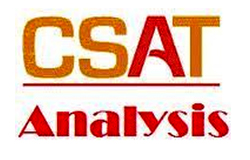Civil Services Prelims- CSAT 2013 Paper II Analysis

Vinnakota Srikanth,
Director,
Analog IAS Institute, Hyderabad
The recent released Results of Civils-2013 have given strong impetus to Civil services’ aspirants in Hyderabad city in a big way. Their motivation levels have gone high as many Telugu speaking students have cracked the UPSC Exam this year. This is a good news for Civil services aspirants in both Telugu speaking state and now more students are aspiring for the Civil Service exam.
The first hurdle in the Civils exam is – clearing Prelims exam is depending on Paper – 2 called Civil Services Aptitude Test (CSAT).
The Seven Test Areas of CSAT
The CSAT was introduced in 2011 and comprises of seven subjects –
- Comprehension
- Basic Numeracy
- Decision Making & Problem Solving
- Analytical Ability & Logical Reasoning
- General Mental Ability
- Interpersonal Skills including Communication Skills
- English Language Comprehension Skills
Each of the 80 questions carries equal marks of 2.5. Out of them, 72 questions attract negative mark of 0.833 (one-third) in case of wrong answer. The remaining 8 questions (on Decision Making & Problem Solving) are not subject to negative marking.
CSAT-2013 Paper II Analysis
Civil Services (Prelims) 2013 - Paper II had 80 questions. Each of the 80 questions carried equal marks of 2.5. And there were 74 questions for which 0.833 marks was deducted for any wrong answer marked. The remaining 6 questions (on Decision Making) did not carry any negative marking. Out of 80 questions, there were 31 English questions (from 12 passages), 24 Reasoning questions, 19 Numerical Aptitude questions and reaming 6 questions were on Decision Making. These questions were placed in a random order.
English part requires good application of logic
In English part, all the questions were pertaining to the passages. The number of questions ranged from 2 to 5 per passage. Out of 12 passages, there were 3 passages which were simple and remaining nine passages were a bit difficult. One does not require any prior knowledge of any particular topic to be able to answer the majority of questions.
However, the questions were such that the answers cannot simply be obtained by just scanning through the passage. One has to read the passage thoroughly, get the essence of it and then look for applying those points in arriving at the answer for the questions. So, these questions demanded good application of logic, and inference and hence clearly were more analytical.
Numeracy and Reasoning requires elementary mathematical skills
The questions pertaining to Numeracy and Reasoning were such that in order to crack them the candidate need to be very good in reasoning and elementary mathematical skills. Overall, the difficulty level of the paper was moderate. For a well prepared candidate, it would not be difficult to score at least 120 marks (out of a maximum possible 200) from this Paper II alone.
Overall-51 easy, 13 medium and 16 difficult
Out of 80 questions, 51 were easy, 13 were of medium and 16 were of high difficulty level. Even if one answers 60 questions with an overall accuracy of 85%, he/she can get to a net score of 120 marks, which is indeed is a good score.
The questions can be classified area-wise. The following table gives the break-up of questions of the seven test areas.
| TEST AREA | NUMBER OF QUESTIONS | MAXIMUM POSSIBLE MARKS | DIFFICULTY LEVEL |
| Comprehension | 23 | 57.5 | MODERATE-DIFFICULT |
| Basic Numeracy | 19 | 47.5 | EASY-MODERATE |
| Decision Making & Problem Solving | 6 | 15 | MODERATE |
| Analytical Ability & Logical Reasoning |
24 |
60 |
MODERATE |
| General Mental Ability | |||
| Interpersonal Skills including Communication Skills | - | - | - |
| English Language Comprehension Skills | 8 | 20 | EASY |
| TOTAL | 80 | 200 | MODERATE |
The following table gives the number of questions - difficulty level wise - with respect to each test area.
|
Test Area | Number of Questions (Level of Difficulty wise) | |||
| Easy | Medium | Difficult | Total | |
| Comprehension | 13 | 3 | 7 | 23 |
| Basic Numeracy | 12 | 4 | 3 | 19 |
| Decision Making & Problem Solving | 4 | 1 | 1 | 6 |
| Analytical Ability & Logical Reasoning | 15 | 4 | 5 | 24 |
| General Mental Ability | ||||
| Interpersonal Skills including Communication Skills | - | - | - | - |
| English Language Comprehension Skills | 7 | 1 | 0 | 8 |
| Total | 51 | 13 | 16 | 80 |
Let us analyse the different types of questions from each of the test area, number of doable questions in each of the test area, and a good net score.
COMPREHENSION
No. of Questions: 23
The paper had 23 questions from a total of nine passages. This test area had some of the questions, for which the answers cannot simply be obtained by just scanning through the passage. One has to read through the passage, get the essence of it and then look for applying those points in arriving at the answer for the questions. These questions demanded good application of logic, and inference and hence clearly were more analytical. However, there were many other questions which were easy in nature.
One of the key highlights, here, was 11 questions out of 23 were followed by two to four statements. In this format, you have to identify the correct/incorrect statement(s)/assumption(s)/inference(s). This format is exactly in line with the question types as given by UPSC in the earlier years’ exams - CSAT 2011 and 2012. In 40 minutes, a good candidate can attempt at least 16 questions with 80% accuracy. Thus, a good score in this test area i.e. 26+ marks can be achieved.
BASIC NUMERACY
No. of Questions: 19
The number of questions pertaining to Basic Numeracy was 19. The questions were from different topics (Numbers, Equations, Ratio, Proportion, Time and Work, Time and Distance, and Data Interpretation). A good student should be in a position to answer at least 12 questions, with at least 80% accuracy in less than 25 minutes.
DECISION MAKING AND PROBLEM SOLVING
No. of Questions: 6
This test area comprises questions from Situation Analysis. Answering these questions will not take much of time, as these types of questions do not demand much of your calculation skills, as what is required in case of Basic Numeracy.
However, in order to answer these questions, a speed and critical reading is required. There was no negative marking for these six questions. At least four of them were doable. A good time allocation strategy is - to attempt all of these questions within 12 minutes.
ANALYTICAL ABILITY AND LOGICAL REASONING, GENERAL MENTAL ABILITY
No. of Questions:24
This test area comprises questions from topics like Number Series, Sequencing, Distribution, Routes & Networks, Cubes etc. Most of these questions were easy and a good student would not have faced much difficulty in answering most of the questions. There were 15, out of 24, easy and doable questions. By answering these questions with at least 80% accuracy, one can score 32+ marks. A good time allocation strategy is – allocating 25 minutes for these questions.
Cut off marks in Prelims:
| Year | Cut Off Mark |
| 2011 | 198 |
| 2012 | 208 |
| 2013 | 238 |
This year i.e. 2014 Prelims, the cut-off may be much higher than 2013, as the aspirants have realized the importance of CSAT in cracking Prelims. It might go up to 260 this year. For Open Category students, this effectively means if they garnered 100marks in GS (Paper– 1), they shall get at least 160 marks (i.e. 64 net correct questions) in the CSAT exam.
Conclusion:
More or less, every year the paper seems to be emphasising on English Reading Comprehension and Reasoning. Though Arithmetic questions seem to be varying every year, an aspirant is supposed to master this area to maximize his score in CSAT paper.
Going by the results of Prelims exam, those who score high in CSAT has an advantage in qualifying the Prelims level. At the same time, Paper –I General Studies has got its own importance as it carries more weightage in Mains. Keeping these things in view, aspirants have to concentrate on both the papers to succeed in this exam.
For CSAT 2012 Paper II Analysis Click Here
For CSAT 2011 Paper II Analysis Click Here


















